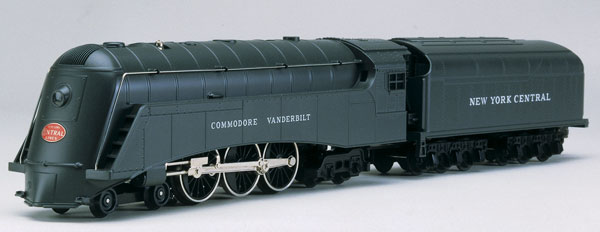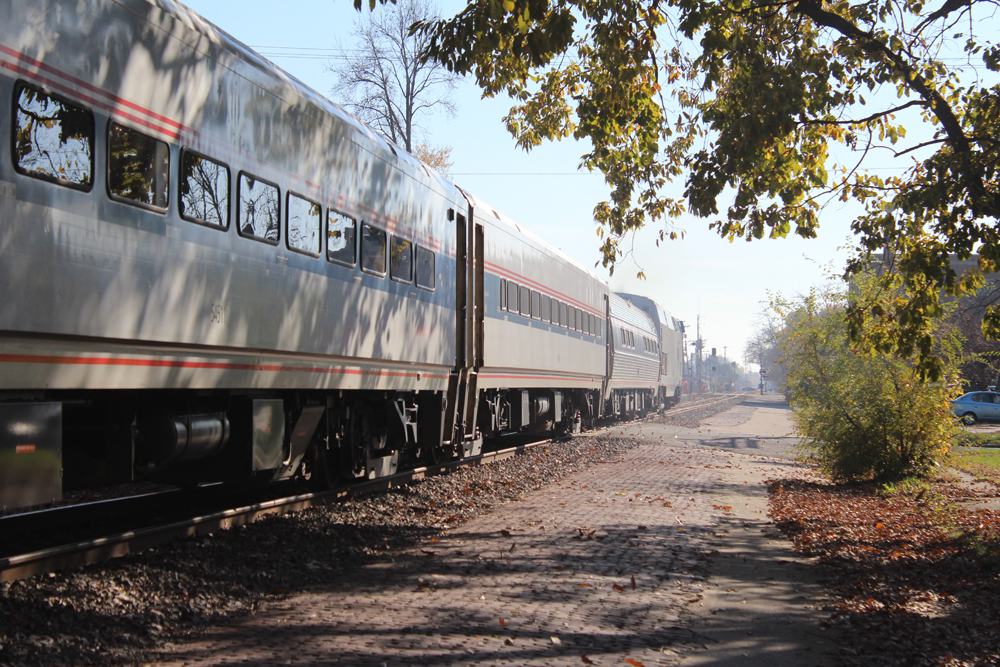The RailKing line has been home to several unusual streamlined Hudsons including the New York Central Dreyfuss Hudson, and the Empire State Express, the Milwaukee Road Hiawatha, the Union Pacific 49er, and now the New York Central Commodore Vanderbilt.
The Commodore Vanderbilt, named after Cornelius Vanderbilt, founder of the Central, made a splash on the prototype rails. The New York Central advertised the Vanderbilt as the world’s first steam-powered streamlined train when it was unveiled in 1934.
Its rakish styling was one that generated either “ooohs and aahs” or derogatory comments about overturned washtubs. Regardless, it was distinctive. It also spawned a look-alike, the 4-8-2 that piloted the Rexall Train, a promotional train for the drug store chain that was operated in the 1930s.
In the toy train realm the Vanderbilt also made its mark – the simple styling and clean lines made it a natural for O gauge, and both Marx and Lionel produced models during the prewar era.
More recently, Lionel produced a scale-like Vanderbilt that was at the center of a particularly heated prototype-versus-toy clash concerning the color of the original (CTT, May 1997). In the end, Lionel ultimately offered light gray, weathered, and near black editions of the engine. As for MTH’s RailKing version, those folks lobbying for a darker engine will be very pleased!
The engine was designed with obvious reference to the prototype, but it is plainly scaled-down for the RailKing line. The engine is 211/4 inches long and 31/2 inches tall, roughly 85 feet long and 14 feet tall in O scale compared to a prototype, unshrouded, J-class Hudson’s 95-foot length and 15-foot height.
Some locomotives may not be good candidates for the RailKing scale-down treatment. I confess that I felt the RailKing Vanderbilt fell into this category before I started to test it. While I think the RailKing Hiawatha looks terrific and the RailKing Dreyfuss Hudson looks regal, I just couldn’t help but think that the Vanderbilt is a little too squat and a little too short.
The die-cast metal shell is impressive, detailed to reflect major reference points on the prototype. Of particular note are the recesses along the top of the boiler where the smokestack, whistle, and bell are placed.
The New York Central Lines shield beneath the headlight is nice since many hobbyists may only be familiar with the more common New York Central System logo applied on later diesels. The dark paint is as neatly applied as are the words New York Central and Commodore Vanderbilt.
The sides of the engine replicate the locomotive’s steel plating nicely. If you’ve seen the scale-like Lionel version, you may have seen the “ripple effect” of the skirting pointed out to you by a proud owner (this duplicates the sheet-metal of the prototype). The RailKing version doesn’t have the ripple, but anything you can’t see unless you get in just the right light probably isn’t all that significant.
The six-axle tender is a beauty, and I especially liked the recessed area concealing the hatches for the water tank. There is what seems to be a simulated light or a receptacle for a backup light on the rear of the tender, but none is installed. A directional light would have given this tyke a little more pizzazz.
The spoked drivers have metal rims, and the silver running gear flashing below the dark gray skirting really stands out. After about eight months of service the prototype Vanderbilt returned to the New York Central shops where its spoked drivers were replaced with disc drivers. Does that mean there may be a disc-drivered version in RailKing’s future? Let’s hope so.
The Vanderbilt’s operation is in line with what we’ve come to expect from MTH products. The motor is fairly quiet, the locomotive sound system is good, and the engine delivers quick response in all speed ranges. The scale low speed average on our test was 33.7 scale mph and the scale high-speed average was 115 scale mph. Drawbar pull was an impressive 2.1 lbs., which roughly approximates 90 modern, free rolling pieces of rolling stock.
And what about the reservations I had about the locomotive’s truncated looks? Forget that! At times I had this engine blazing around a 16 x 22-foot layout with a 14-car freight train and with the locomotive drawing about 13 volts. In the straightaways I nudged the throttle up even higher, and it always seemed as though this little engine had more power to spare. It looks sharp and this steamer really has hustle to move cargo.
It was at that moment that it dawned on me that MTH’s investment in quality tooling, first rate electronics, a modern motor, and solid craftsmanship have resulted in a quality toy train.
I stress toy because this Vanderbilt is the ultimate evolution of the Marx or Lionel prewar engine, and that is not a bad thing! This engine is a unique-looking locomotive that pulls well and is fun to run.
If you want a distinctive-looking steamer that is roaring to move cars, check out RailKing’s Commodore Vanderbilt.














